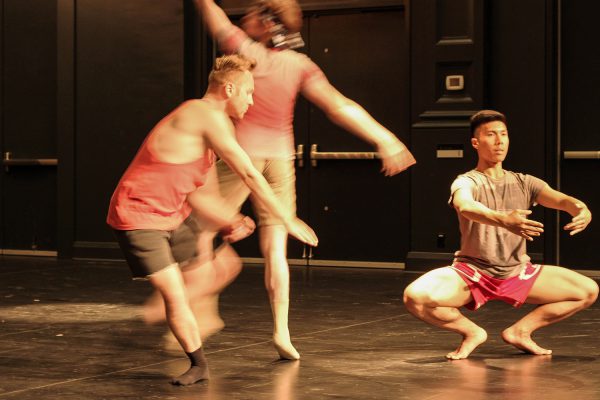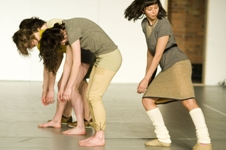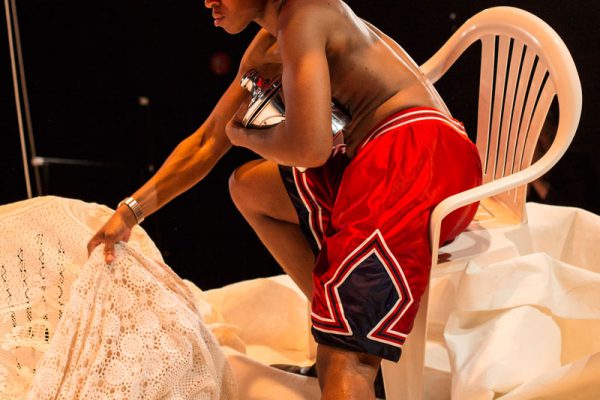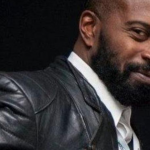If the world of contemporary dance is a bit of a closed community, not always so welcoming to outsiders who come from other than the conventional channels, the world of classical ballet is more so — a family compact. You’d better be bringing something pretty special as an offering to the patriarchs if you hope to sit down at the dinner table and be listened to.
Enter Hillar Liitoja, radical theatre artist of long-standing notoriety in Toronto, bottle of Alsatian Riesling in one hand and a passion for ballet in the other.
Trained as a concert pianist, Liitoja began making theatre in the eighties, establishing his company DNA as a laboratory for environmental stagings and installations of (often) challenging ideas. Liitoja’s obsessions have been deep and serial — Ezra Pound, Antonin Artaud. But his plays have also tapped into the zeitgeist, albeit in unconventional ways: witness “The Last Supper” (a real time dramatization of an act of euthanasia), “This Is What Happens In Orangeville” (about hate crimes in a small Ontario community) and “Paula and Karl” (obviously, a two-hander about Paul Bernardo and Karla Homolka). Liitoja’s fascination with dance is a long-standing one. He’s a devoted fan of artists like Belgium’s Anne Teresa de Keersmaeker and Germany’s Pina Bausch, artists who blend choreographic genius and a flair for theatricality with the utmost of rigour. And he’s used movement in almost all his performance works, choreographed to a greater or lesser degree. His “Iron Dance” in 1994’s “Poundamonium” was borrowed by Patricia Rozema for her film “When Night Is Falling”; he created an ensemble movement work in 1999 called “Phalanx”; and a solo for ballerina called “Remnants” that went on to the High Performance Rodeo in 2000.
But it’s a long stretch from incorporating dance elements into theatre work, however unconventional, to choreographing a full-length ballet using pointe work and all the other features of the classical vocabulary. Liitoja managed the feat on June 30th, premiering an eighty-minute work for a cast of six ballerinas aged fifteen to fifty-seven with the unwieldy but evocative title “I Know and Feel That Fate Is Harsh But I Am So Loathe To Accept This”.
As part of a team capturing footage for a documentary about Liitoja, I had an opportunity to observe parts of the creation process for this work. This circumstance created a bias that I’ll disclose upfront. This bias caused me to view the finished production in a way the typical reviewer or audience member couldn’t. This was my fate. And I accept it.
In the beginning — as always with Liitoja — there were words. “I’d been thinking about fate for YEARS”, Liitoja points out. “Fate was always going to be the issue at hand with this work. Even though I do not personally believe in Fate.” What Liitoja did and does believe is that he and his company are jinxed. But that’s not quite the same thing, is it?
Liitoja began work on his ballet while observing National Ballet of Canada Artistic Director James Kudelka, during part of a mentorship program through Theatre Ontario. “He placed an enormous trust in me based on his experience with ‘The Observation’. [The Observation was an installation performance in Liitoja’s home that Kudelka had attended. The audience was required to experience the piece individually, with Liitoja greeting them personally upon completion of the experience.] His goodwill and moral support — especially in the early stages of creation — were just tremendous,” says Liitoja.
At the same time he was watching the creation of Kudelka’s “Cinderella”, Liitoja was watching dancers take class. “I didn’t have the knowledge to be judging their technique,” he says now. “I was looking for a quality of working, a focus and a discipline. I was looking for an intensity at work.” Once chosen, each ballerina was quizzed on her thoughts and feelings about fate. These ideas were processed by Liitoja, the performers and dramaturge John Delacourt into poetic monologues that were then deconstructed word for word. Movements were assigned to each word creating a kind of lexicon of dance phrasing. Liitoja worked with each dancer individually, eventually stringing each word/movement into a danced monologue. The dancers (or at least those who made it all the way through Liitoja’s sixteen-month process) finally came together when the production moved into the Winchester Street Theatre and began rehearsing with the elements of Liitoja’s designed environment. These included an alternately thundering and muted score of classical music mixed by Steve Marsh, an intricate grid of hanging light bulbs, each one on a separate dimmer (devised by Rebecca Picherak and Sandra Marcroft after a concept of Liitoja’s) and a subtly textured dance floor painted by David Duclos.
Liitoja is infamous for “managing” his audiences — telling them where and how to sit, allowing them to enter the performance space a few at a time or not at all — and this production is no exception. The ballet is well underway with lights and sound at full volume by the time most people have taken their seats in the house or ranged on the floor along two sides of the space. On opening night, a moment of vintage Hillar occurred when a gentleman seated himself on the perimeter of the dance floor with one foot extending slightly onto the painting. After repeated pleas from an usher were ignored, Liitoja himself left his seat to rearrange the man’s foot. “Leave if you don’t like it,” Liitoja shouted over his shoulder and giggles broke out across the house.
Hillar-esque interventions such as this one are not unusual for DNA, but the encounter did publicly underscore Liitoja’s passionate concern for his cast. “They rule,” he told me at one point and, such was the evident joy he exhibited working with Zoë Anderson-Jenkins, Maggie Forgeron, Mariline Goodhue, Vanessa Harwood, Leslie Schroeter and Magdalena Vasko, that I did not doubt it. Physical risk-taking was required for this unusual ballet but was never asked for or undertaken foolishly.
About eighty minutes in length, the work is comprised of dancers entering, going about their business and only rarely interacting with each other or the audience before nonchalantly leaving. In self-contained auras, each dances her thoughts on fate, expressing life experience and personality in an organically realized series of gestures, steps and poses that was built over months of deconstruction and renovation in the studio. All of the performers are technically assured, well trained and able to do the steps (even though Harwood doesn’t go on pointe, one senses that she could). But what Liitoja has created is more of a showcase for their artistry as actors, their depth as human beings. And it’s upon this idea that one must gauge the success or the failure of the performance.
As might be expected, each dancer has a unique vocabulary of gestures, steps and attitudes. Mariline Goodhue is the most physical, in a way, performing multiple grand jetés and running backwards. She also revels (as does Maggie Forgeron) in falling heavily to the ground, the noise and collapsing posture a very antithesis of the floating ballerina. She floats on occasion as well, reaching for those light bulbs that flicker and pulse.
Leslie Schroeter personifies all that is light and flirtatious — she’s the ingénue of this piece and her performance is charming with precise pointe work and delicate port de bras. She also has the most interactivity with the audience. Liitoja has envelopes falling periodically from the ceiling — each containing a card inscribed with instructions for the dancer who picks it up and then hands it to a member of the audience: “entrechat quatre, smile at the person, pirouette, shake wrists and repeat to all four corners”, for example. Magdalena Vasko is all serene rock-solid technique, but oddly that is less compelling in the context Liitoja has created. I found myself looking for the raggedy edges that signal real human effort rather that the technical perfection that is a built-in expectation of classical ballet. For me, that quality was provided mostly by Forgeron, who, while seeming technically a bit of mess, ended up delivering one of the more moving and intriguing of performances.
Vanessa Harwood, too, offered real depth with her performance. True, you can’t fault her technique, but let’s face it, ballet was designed to be performed by the young. What the fifty-seven-year-old former ballerina offered in this surprising and welcome comeback might be called the vestiges of an impeccable technique. This in itself is moving, but combine it with infinite artistry of a distinct emotional and spiritual nature and Harwood’s performance leaves you wondering why the great stars of classical ballet so often leave the stage entirely when they retire. Could the classical idiom not be adapted somehow to accommodate its most accomplished artists? By contrast, Zoë Anderson-Jenkins, at age fifteen, is clearly still a student of dance. Her most significant contribution is extreme youth and how that resonates as a balancing device against the rest of the cast.
The ballet ends in interesting fashion with a few sensory treats for those audiences (all of them as it turns out) who stand in ovation. The lights dim and a cascade of objects falls from the ceiling with a crash. Though it’s too dark to make out what the objects are, after a few moments, the nose knows. Limes.
All in all, it’s an endearing ensemble and a daring endeavour executed with sincerity, humour and great production values. Big round of applause for all involved. That said, Liitoja’s show raises more than a few interesting questions. For example, why apply extreme rigour to a creation process but do everything in your power to hide that process from your audience? Is Liitoja bolstering or subverting the fact that ballet in North American is largely based on the comfortable fulfillment of long-standing expectations? If you’re calling something radical, shouldn’t it challenge ALL of the conventions in an overt way?
I can’t wait to see what Liitoja comes up with next. I dearly hope it’s another ballet.
Tagged: Ballet, Contemporary, Performance, ON , Toronto





